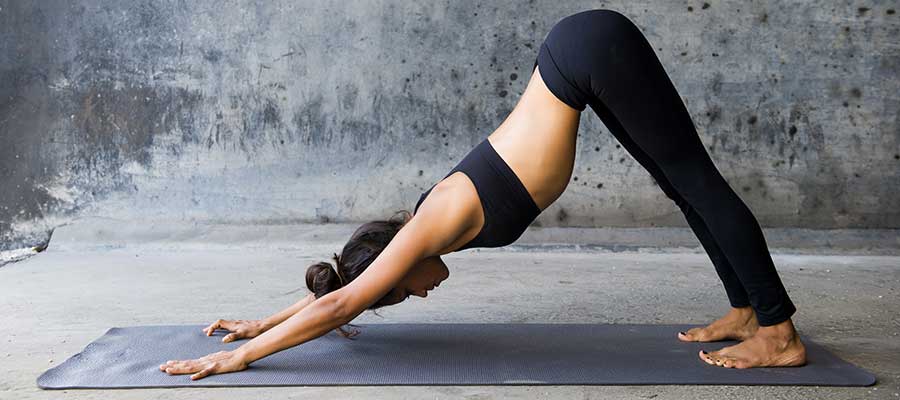
Downward dog
You can attend any type of yoga class and we bet that at some point, your instructor will instruct you to go into a downward dog pose. Downward dog (Adho Mukha Svanasana) is an iconic pose for yoga. The reason it has become the best-known asana is that it’s so important in contemporary practice. It may be the first pose you learn as you begin a yoga practice. It is done many times during most yoga classes, particularly in Vinyasa yoga. This is why downward dog is one of yoga’s most loved asanas.
Benefits
Strength + stretch: Downward dog acts as both a strengthening and stretching pose. It stretches your hamstrings and calves as well as strengthens your arms, legs, and back. It can help relieve back pain. As a mild inversion, it acts in reverse of the usual forces on your spine and brings more blood flow to your brain. The pose also strengthens the deep abdominal muscles (transversus muscles) that help to stabilise the spine.
Eases tight hamstrings: Walking, standing and sometimes even running are actions that are performed on a daily basis in our day-to-day activities. These actions bring tension to the back of the legs which is why many of us are living with chronically tight calves and hamstrings. Downward dog is an excellent stretch for opening the back of the legs and providing relief from this common issue.
Easy focus on breath: In yoga, we often speak about focusing on your breath, and hey, we get it! This can be quite difficult if you are trying to focus on holding a particularly difficult pose. Because downward dog is not a very complicated pose, and thus there’s less chance of injury, you can really slow down in it and take some time to tune into your breath – helping you to zone into this very important aspect of yoga.
Strong bones: This pose is also great for strengthening your bones. As we’ve mentioned earlier, downward dog strengthens the arms. If you’re a yoga newbie, even holding downward dog for a few seconds can cause the muscles in your upper half to tremble. This is good—shaking means the muscles in the arms and shoulders are being challenged as they support more of your body weight. Not only do poses like downward dog promote upper body strength; they also strengthen bone density and help prevent osteoporosis.
Works out those knots in your back: Another great benefit of this pose is the fact that it strengthens the core. All movement comes from your core, and thus ensuring that you have a strong core will enhance all subsequent asanas. As your body forms an inverted V of the downward dog, your abdominals feel engaged as they support the spine and prevent you from caving in through the chest. Not only will this pose strengthen your core, but it will also loosen your spine, shoulders, and back. For instance, in downward dog, the shoulders melt down the back, the upper back fans out, and the spine is properly aligned to promote flexibility and ease tension.
For these reasons, downward dog is the poster pose of yoga. You can also find benefit from practising this pose at home outside of your yoga class
FAQs
How can I correctly perform a downward dog asana?
1) Begin in a kneeling position on your mat with hands directly under shoulders, fingers spread wide.
2) Tuck your toes under and engage your abdominals as you push your body up off the mat so only your hands and feet are on the mat.
3) Press through your hands moving your chest gently toward your thighs and your heels gently toward the floor.
4) Relax your head and neck and breathe fully.
What does my instructor mean by “no banana backs” when we are performing downward dog?
Your instructor is concerned with the proper technique when performing your asanas. If you are very flexible, try not to let your rib cage sink towards the floor creating a sinking spine (also known as banana back). Draw your ribs in to maintain a flat back.
How can I make my downward dog more challenging?
You can deepen the pose by lifting your heels slightly from the floor and placing the weight on the balls of your feet. Draw in your pelvis and then return your heels to the floor.
Don’t forget to share this via Twitter, Google+, Pinterest and LinkedIn.
